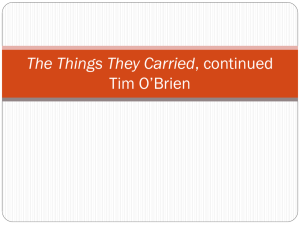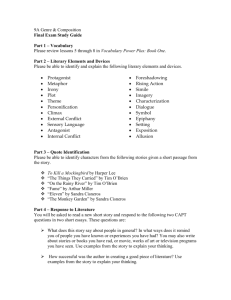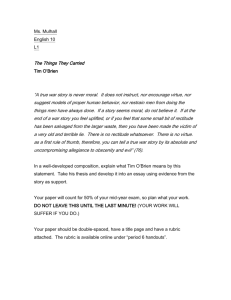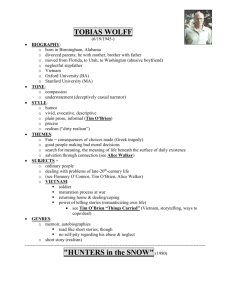LAP #5 - WordPress @ Clark U
advertisement
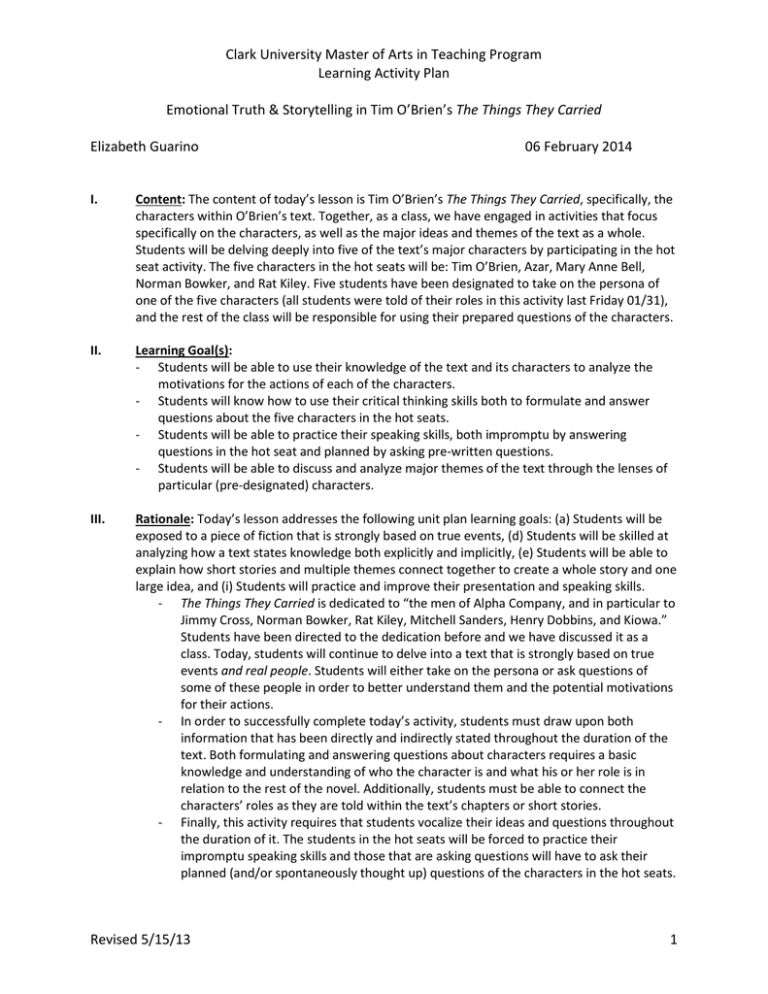
Clark University Master of Arts in Teaching Program Learning Activity Plan Emotional Truth & Storytelling in Tim O’Brien’s The Things They Carried Elizabeth Guarino 06 February 2014 I. Content: The content of today’s lesson is Tim O’Brien’s The Things They Carried, specifically, the characters within O’Brien’s text. Together, as a class, we have engaged in activities that focus specifically on the characters, as well as the major ideas and themes of the text as a whole. Students will be delving deeply into five of the text’s major characters by participating in the hot seat activity. The five characters in the hot seats will be: Tim O’Brien, Azar, Mary Anne Bell, Norman Bowker, and Rat Kiley. Five students have been designated to take on the persona of one of the five characters (all students were told of their roles in this activity last Friday 01/31), and the rest of the class will be responsible for using their prepared questions of the characters. II. Learning Goal(s): - Students will be able to use their knowledge of the text and its characters to analyze the motivations for the actions of each of the characters. - Students will know how to use their critical thinking skills both to formulate and answer questions about the five characters in the hot seats. - Students will be able to practice their speaking skills, both impromptu by answering questions in the hot seat and planned by asking pre-written questions. - Students will be able to discuss and analyze major themes of the text through the lenses of particular (pre-designated) characters. III. Rationale: Today’s lesson addresses the following unit plan learning goals: (a) Students will be exposed to a piece of fiction that is strongly based on true events, (d) Students will be skilled at analyzing how a text states knowledge both explicitly and implicitly, (e) Students will be able to explain how short stories and multiple themes connect together to create a whole story and one large idea, and (i) Students will practice and improve their presentation and speaking skills. - The Things They Carried is dedicated to “the men of Alpha Company, and in particular to Jimmy Cross, Norman Bowker, Rat Kiley, Mitchell Sanders, Henry Dobbins, and Kiowa.” Students have been directed to the dedication before and we have discussed it as a class. Today, students will continue to delve into a text that is strongly based on true events and real people. Students will either take on the persona or ask questions of some of these people in order to better understand them and the potential motivations for their actions. - In order to successfully complete today’s activity, students must draw upon both information that has been directly and indirectly stated throughout the duration of the text. Both formulating and answering questions about characters requires a basic knowledge and understanding of who the character is and what his or her role is in relation to the rest of the novel. Additionally, students must be able to connect the characters’ roles as they are told within the text’s chapters or short stories. - Finally, this activity requires that students vocalize their ideas and questions throughout the duration of it. The students in the hot seats will be forced to practice their impromptu speaking skills and those that are asking questions will have to ask their planned (and/or spontaneously thought up) questions of the characters in the hot seats. Revised 5/15/13 1 Clark University Master of Arts in Teaching Program Learning Activity Plan Emotional Truth & Storytelling in Tim O’Brien’s The Things They Carried Elizabeth Guarino 06 February 2014 IV. Assessment: One way it will be evident that students have reached the learning goals is based on their oral performance during class time. Students’ oral participation will clearly show myself and the class, which students have read, understood, and analyzed the text as thoroughly as expected throughout the duration of our whole unit. The complexity of students’ questions will also illustrate students’ understanding. Another way that the learning goals will be assessed is through the exit slip that students will complete at the end of today’s class. The exit slip asks students to complete the following sentences: (1) The best part of today’s class was… and (2) The most important thing I learned today was… These two sentence starters aim to show firstly, what about the activity was enjoyable (so I can inform my own teaching practice about what worked and what did not work), and secondly, what the “takeaway” is from today’s lesson. I will also have students’ pre-written questions to compare their actual questions (i.e. what students actually asked of the characters in the hot seats and how that changed or did not change from their brainstormed questions). Additionally, the reason for not giving an additional activity to the students not in the hot seats is because I would like for everyone to be engaged and participating in the asking and answering of questions. V. Personalization and equity: The students that have been chosen to participate in the asking of questions and those that have been chosen to be participants in the hot seats are based on student comfort and my knowledge of their abilities. For the hot seats, I have chosen some students that have strong voices and others that are comfortable speaking out in class but choose not to do so very often. Furthermore, as previously mentioned, I have done my best to match students up with characters that they are somewhat compatible with. The fact that students have had time to write questions for and prepare to take on the personas of the characters prior to today’s activity is one way that some of the pressure of asking questions has been lowered and the lesson has been scaffolded. In terms of ELLs and students with learning disabilities, the directions have been given to students prior to today’s lesson, and have been repeated right before beginning the activity. Each of the characters will also have a nametag on that identifies who they are. The exit slip will also be telling in that it will alert me of if the amount of scaffolding that has been done for this lesson was sufficient or not. VI. Activity description and agenda a. Agenda (1 hour class period): - (5 minutes) Prepare for and move into roles for hot seat activity - (45-50 minutes) Hot seat activity! Five students have been designated to play a character from Tim O’Brien’s The Things They Carried. Students will ask pre-written and/or spontaneously chosen questions about each of the five characters. Each character will be in the hot seat for 7-10 minutes. - (5-10 minutes) Exit slip: Complete the following sentences: (1) The best part of today’s class was… (2) The most important thing I learned today was… - *EXTRA TIME?* If we get through today’s activities faster than anticipated, we will open up questioning to all characters at one time and allow for visitors to join in the questioning of our characters. This will occur before we complete exit slips. Revised 5/15/13 2 Clark University Master of Arts in Teaching Program Learning Activity Plan Emotional Truth & Storytelling in Tim O’Brien’s The Things They Carried Elizabeth Guarino 06 February 2014 b. Challenges: I am worried that we will either run out of time (as every class time usually seems to go by faster than expected), or we will have some extra time. I planned extra activities, in case we run out of time. I am also worried that some students (in the hot seats) might be absent. To avoid any major issues that may be caused because of this, I have chosen “back up” characters and I have told students to anticipate being called up to the hot seat if their classmates are absent (I am hoping this is an incentive for students to encourage their friends to be present during the hot seat activity). I am also unsure of how long the hot seat activity will last. I am confident that with five characters, we will take all allotted class time to complete this activity, however, if we finish earlier than anticipated, I have planned to continue group presentations of the graffiti project. Additionally, if we run out of time and have a significant amount of questions that students have not be able to ask of the characters, then we will continue the hot seat activity tomorrow. VII. List the Massachusetts Learning Standards this lesson addresses. - L.10.1 Demonstrate command of the conventions of standard English grammar and usage when writing or speaking. - SL.10.3 Evaluate a speaker’s point of view, reasoning, and use of evidence and rhetoric, identifying any fallacious reasoning or exaggerated or distorted evidence. - SL.10.6 Adapt speech to a variety of contexts and tasks, demonstrating command of formal English when indicated or appropriate. - W.10.MA.3.A Demonstrate understanding of the concepts of point of view by writing short narratives, poems, essays, speeches, or reflections from one’s own or particular character’s point of view. VIII. Reflection a. In light of all areas of planning, but especially in terms of your stated purpose and learning goals, in what ways was the activity(ies) successful? How do you know? In what ways was it not successful? How might the activity be planned differently another time? b. What did you learn from the experience of this lesson that will inform your next LAP? Revised 5/15/13 3

